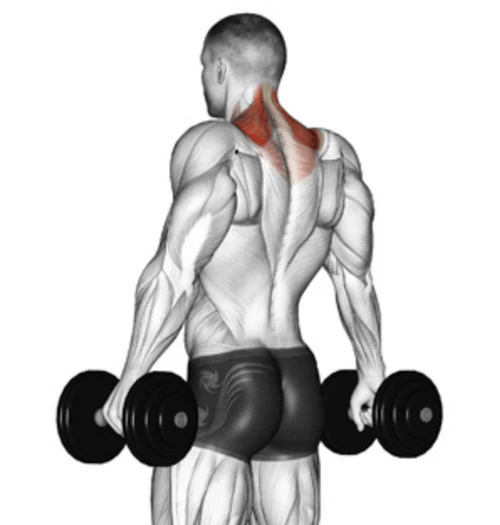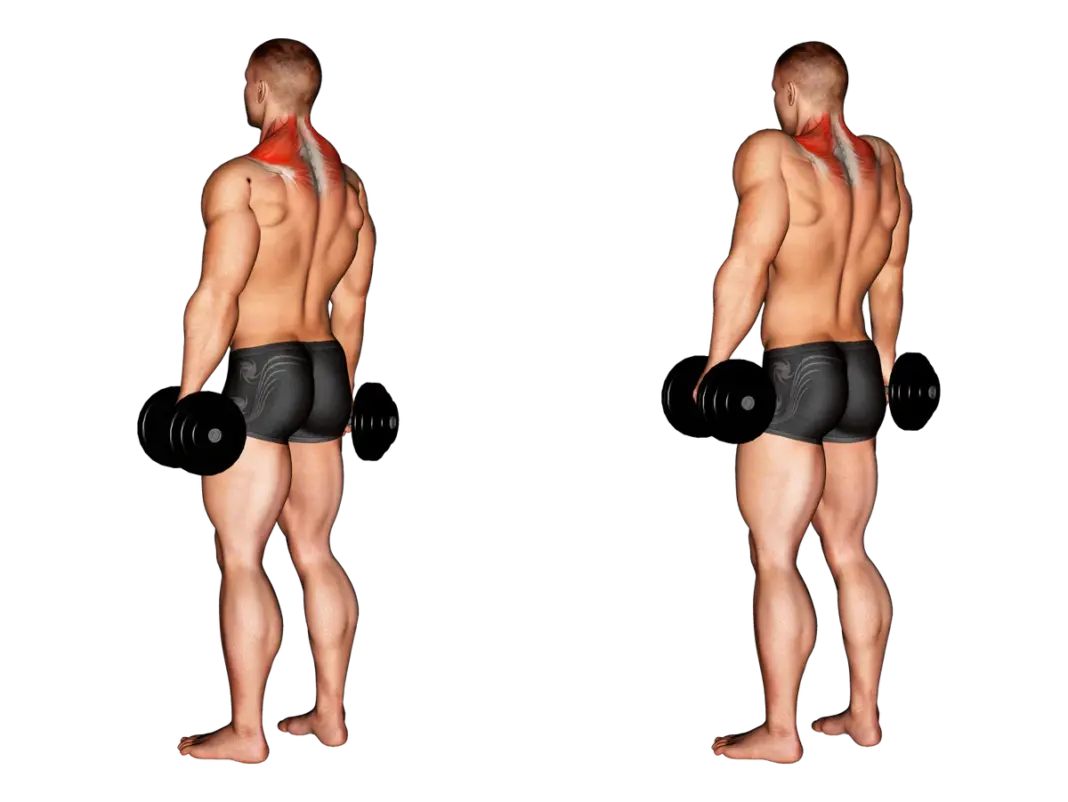Best Shrug Variations Ranked: Build Traps That Dominate
If your shrug game begins and ends with a few rushed sets of dumbbells at the tail end of back day, you’re missing out on serious trap growth.
For bodybuilders, shrugs aren’t just another accessory lift — they’re the cornerstone of upper trap development and the foundation of a wide, thick, powerful-looking physique.
But here’s the truth most lifters ignore: not all shrugs are created equal. Some variations are biomechanical goldmines for trap activation, while others turn into momentum-driven ego lifts that do little beyond inflating your logbook.
This guide breaks down shrug variations ranked by effectiveness, explains why some deliver more growth than others, and gives you the tools to build traps that not only stand out but dominate the stage, the gym, or anywhere you walk into.
Why Shrugs Matter for Trap Development
The trapezius — or traps — isn’t just one muscle. It’s a large diamond-shaped sheet that runs from the base of your skull, across your shoulders, and down to the middle of your back. It’s divided into three functional regions:
- Upper traps: Elevate your shoulders (classic shrug motion).
- Middle traps: Retract the shoulder blades.
- Lower traps: Depress and stabilize the scapula.
Shrugs specifically hammer the upper traps, the part of the muscle that gives you that thick, yoke-like appearance from the front and side. Big upper traps complete the physique — they frame the neck, enhance shoulder width, and give your torso that dominant, powerful silhouette.
The catch? Most lifters perform shrugs poorly, with short ranges of motion, sloppy form, and way too much momentum. To grow your traps, you need the right variation, proper load path, and complete control.

What Makes a Shrug Variation Effective?
Before ranking shrug variations, let’s define the criteria that matter most:
- Full Range of Motion (ROM): The traps respond best when stretched at the bottom and fully contracted at the top. Partial reps leave growth untapped.
- Proper Load Vector (Line of Pull): The resistance should line up with the natural shrug path. If the bar drifts forward or the resistance isn’t vertical, you lose tension.
- Tension at Peak Contraction: The traps grow when you squeeze hard at the top — some variations naturally allow this better than others.
- Minimal Cheating/Momentum: Swinging heavy weight with bent arms isn’t trap training; it’s just wasted effort.
With these principles in mind, here’s how the best shrug variations stack up.
Shrug Variations Ranked by Effectiveness
🥇 1. Trap Bar Shrugs — The King of Shrugs
- Why they work: The trap bar places the weight at your sides, directly under your center of gravity. This allows for a natural shrug path and heavy loading without pulling your torso forward.
- Best for: Heavy sets, progressive overload, balanced trap growth.
- Bodybuilder tip: Grip the handles tight, keep arms straight, and pause at the top for a one-second squeeze. Add static holds for even more upper trap recruitment.
👉 If you want thick traps that scream strength, start here.
🥈 2. Dumbbell Shrugs — Strict and Symmetrical
- Why they work: Dumbbells allow each side to move independently, preventing strength imbalances. They also give you freedom of motion — you can angle your shoulders slightly forward or back to find the best contraction.
- Best for: Strict isolation, symmetry, and mind-muscle connection.
- Bodybuilder tip: Perform these slow, with a full stretch at the bottom and a two-second squeeze at the top. Go for higher reps (12–20) to build both size and endurance.
🥉 3. Behind-the-Back Barbell Shrugs — Stretch and Squeeze
- Why they work: Holding the bar behind your body forces an upright posture and provides a deeper stretch on the traps at the bottom of the movement.
- Best for: Lifters with solid mobility who want an intense stretch and contraction.
- Bodybuilder tip: Start light and focus on form. Keep your chest tall, avoid leaning forward, and pull your shoulders straight up — not backward.
🔹 4. Barbell Shrugs (Front) — The Classic Heavy Hitter
- Why they work: A staple for decades, barbell shrugs allow for progressive overload. However, the bar sits in front, which can cause leaning or momentum if you’re not strict.
- Best for: Moving heavy weight in lower rep ranges.
- Bodybuilder tip: Don’t roll your shoulders — straight up and down only. Use straps if grip is a limiting factor.
🔹 5. Cable Shrugs — Constant Tension Finishers
- Why they work: Cables provide smooth resistance and constant tension throughout the ROM. They shine as a high-rep, controlled finisher when free weights have already smoked your traps.
- Best for: Burnout sets, mind-muscle focus, pump work.
- Bodybuilder tip: Stand slightly back from the stack so the line of pull hits directly vertical. Hold each rep at the top for a brutal contraction.
🔹 6. Smith Machine Shrugs — Locked-In Control
- Why they work: The fixed bar path eliminates balance issues, letting you focus purely on contraction. You can push volume and accumulate metabolic stress without worrying about form breakdown.
- Best for: High-volume training, drop sets, and trap pumps.
- Bodybuilder tip: Use these at the end of a session for long sets (15–25 reps). Focus on squeezing every rep, not just moving the bar.
🔹 7. Incline Dumbbell Shrugs — Underrated Mid/Lower Trap Builder
- Why they work: Performed chest-down on an incline bench, these shrugs shift the line of pull backward, targeting mid and lower traps along with the upper fibers.
- Best for: Posture correction, balanced trap development, lifters prone to forward head posture.
- Bodybuilder tip: Use light weights and higher reps (15–20). This is more about quality contraction than heavy loading.
How to Program Shrug Variations
Traps respond well to both heavy overload and high-tension volume work. The sweet spot is training them twice per week, rotating between heavy, low-rep shrugs and lighter, higher-rep variations.
Programming Blueprint
- Heavy shrug (trap bar or barbell): 4 sets of 8–10
- Volume shrug (dumbbells, cables, Smith): 3 sets of 12–15
- Incline/postural shrug: 3 sets of 15–20
Weekly Split Example
- Day 1 (Heavy focus): Trap Bar Shrugs + Dumbbell Shrugs
- Day 2 (Volume focus): Cable Shrugs + Incline Shrugs
This balance ensures your traps get loaded from all angles, with both mechanical tension (heavy lifting) and metabolic stress (volume and contraction).
Sample Shrug-Focused Trap Workout
- Trap Bar Shrug – 4 x 10
- Dumbbell Shrug (strict, slow squeeze) – 3 x 12–15
- Incline Dumbbell Shrug – 3 x 20
- Cable Shrug (finisher, pump focus) – 2 x 20–25
Add this to your pull or upper-body days twice per week. Within 6–8 weeks, you’ll see noticeable thickness across the upper traps.
Practical Tips for Shrug Training
- Stretch fully at the bottom. Don’t cut range short — traps grow from the stretch.
- Pause at the top. Hold each rep for at least one second. Momentum kills growth.
- Use straps if needed. Grip fatigue shouldn’t limit trap overload.
- Mix rep ranges. Go heavy some days, high-rep other days. Traps thrive on variety.
- Pair with carries. Farmer’s carries, yoke walks, and heavy holds are underrated trap builders that complement shrugs perfectly.
Common Shrug Mistakes to Avoid
- Rolling shoulders. This adds joint stress without more trap activation. Keep the motion vertical.
- Using bent arms. Shrugs are not upright rows. Keep elbows locked.
- Ego lifting. If you’re heaving the weight with no squeeze, drop it.
- Training traps once a month. Frequency builds thickness. Twice a week is ideal.
- Ignoring posture shrugs. Upper traps look impressive, but balanced mid/lower trap work keeps your shoulders healthy.
Final Word: Shrugs That Actually Work
Shrugs aren’t just a box to tick at the end of back day. They’re a direct path to building a dominant upper body. But to get the most out of them, you need to choose the right variation for your goals, train with intent, and execute with precision.
Whether you’re piling plates on a trap bar for heavy mechanical overload, chasing the burn with dumbbells, or polishing your posture with incline shrugs, the formula is the same: heavy + strict = yoke growth.
Don’t just shrug for the sake of shrugging. Shrug like it counts. Because when it comes to bodybuilding, big traps aren’t optional — they’re the mark of power.
🔗 Related Articles:
- Best Neck and Trap Exercises
- Trap Training 101
- Neck Training for Bodybuilders
- 30-Minute Neck & Trap Workout
- Home Trap and Neck Training




